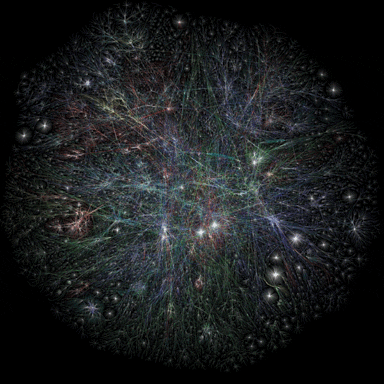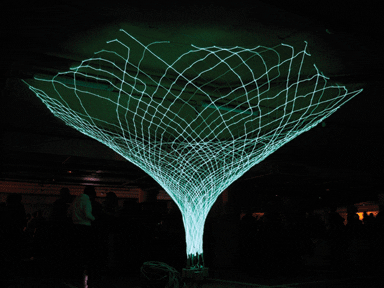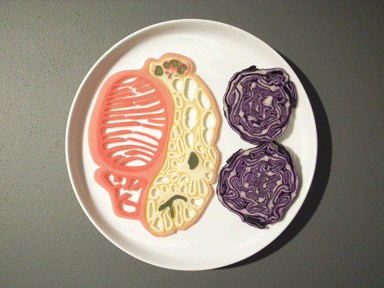
words Bill Mitchell
Designers routinely lay claim to avant-garde status by asserting that their work is grounded on “new technologies”. This, they suggest, sets them apart from those hopeless fogies who are content to rely upon “old technologies”.
The large and ambitious exhibition Design and the Elastic Mind, at New York’s Museum of Modern Art, continues this time-honoured tradition. According to its website, it explores “designers’ ability to grasp momentous changes in technology, science, and social mores… and convert them into objects and systems that people understand and use”, highlighting “examples of successful translation of disruptive innovations”.
What are these disruptive innovations? The answers have, of course, changed over time. A century and a half ago, Eugène Viollet-le-Duc seized upon cast iron as his material of the future. In the 1940s, Nikolaus Pevsner assured us that the pioneers of modern design had created a revolution by turning to new industrial materials and processes – steel, concrete, glass, plastic, and mass production. According to the curatorial choices of this show, the cast-iron-equivalents of our time are digital information, electronic tagging and sensing, networking and distributed intelligence, computer visualisation of data, robotics, nanotechnology, and computer-controlled fabrication technologies such as 3D printing.
This represents a significant departure for MoMA, which has for too long clung to an increasingly retro, Pevsnerian conception of modern design. Even more welcome is the show’s focus on adventurous young designers, together with its embrace of cross-disciplinary collaborations and thinkers and makers from outside the design mainstream. The inclusion of interactive pieces even challenges the venerable institution’s look-but-don’t-touch ethos – which has always been problematic when showing things that were made to be used.
It also makes for a crowded, messy and not always coherently conceived exhibition. The show is a collection of interesting and diverse high-tech treasures, but there are too many of them for comfortable viewing, the space is jammed, and the principles of inclusion are often unclear.
Some of the most engaging pieces are very modest, but profound in their implications. Mathematician Erik Demaine shows some astonishing examples of curved origami that could have many architectural and product design uses. The paper forms were derived computationally, and then folded by hand, to reveal a new world of complex 3D shapes that has barely been explored.
There are many examples of objects created by computer-controlled devices – CAD/CAM cutting, milling and printing machines. Neri Oxman presents wonderfully tactile, sensual pieces fabricated from mixed materials and technologies. Patrick Jouin, Front, Janne Kyttanen and Joris Laarman all explore the surprising possibilities of 3D-printed furniture. And there’s Tomás Gabzdil Libertiny’s vase [see our news feature, page 66] produced by “multiple intelligent deposition devices working in parallel” – bees.
The interaction design pieces aren’t particularly interesting, but there are some more impressive projects exploring digital information display. Invisible things, like theinternet and the information encoded in the human genome, are made present by digital means. And the SENSEable City Laboratory shows a particularly vivid visualisation of telecommunications traffic in and out of New York – making concrete the abstract idea of a “global city”.
As you explore the show, an uneasy doubt grows. Haven’t most of these technologies been around for quite a while? Isn’t MoMA still way behind the times? CAD/CAM technology was first explored at MIT in the 1950s, and has long been commonplace in many areas of industry. Computer networking emerged in the 60s. The golden era of computer graphics innovation began in the 70s. The microprocessor and personal computer revolutions unfolded through the 80s, and the dotcom bubble had come and gone by the end of the 90s. Many research laboratory directors and venture capitalists already see nanotechnology as yesterday’s craze.
Yet to engage designers in significant ways, technologies have not only to exist, but also to become inexpensive and commonplace enough to get into the hands of large numbers of students and practitioners. It usually takes time. It has only been in the last few years, for instance, that laser cutters, 3D printers and other CAD/CAM devices have become standard equipment in schools of architecture and design, and in everyday practice. There are similar stories to tell about the other technologies represented here.
In truth, the projects on view in Design and the Elastic Mind have mostly not been inspired and enabled by recent discoveries. They derive, instead, from extended processes of commercialisation and marketing of technologies that – like the baby-boomers who produced them – are now teetering on the threshold of old age.
top image Michael Burton’s Nanotopia, 2006-7

Oded Ezer’s Typosperma, 2007

Barrett Lyon’s Mapping the Internet, 2003

Rachel Wingfield and Mathias Gmachl’s Sonumbra, 2006

James King’s Dressing the Meat of Tomrrow, 2006


















